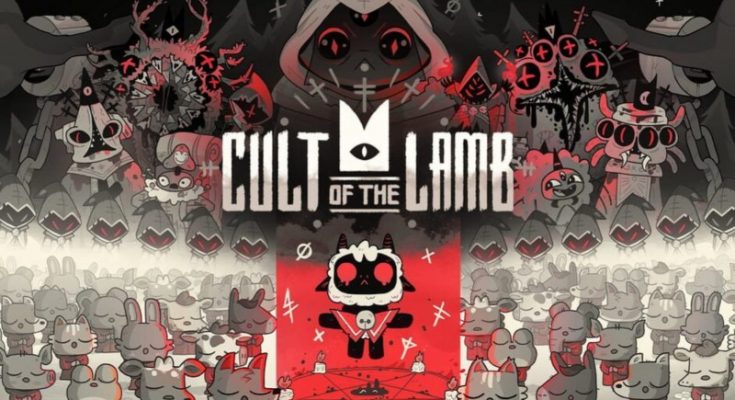I loved Animal Crossing: New Horizons in 2020, but its premise wasn’t enough to keep me hooked over time. Designing my island and keeping all the villagers happy on it was completely enjoyable, but after a few dozen hours, I was craving a new type of gameplay to match what I was doing every day. Cult of the Lamb, specifically a mish-mash of cute animals, critters, and creatures and macabre cult-isms, treats that issue with an elaborate action-combat dungeon system. I only wish that its base construction would provide the same kind of satisfaction that the combat does. While I wanted to focus on aesthetically designing a cult game, I found the game stretching its hand to focus on resource management, which is something I’d otherwise be enjoying. It’s fun to build your cult from the ground up and design its headquarters, but you’re soon tempted to use your cult as a means to build up in-game currencies and resources, and it can sometimes really gets in the way of feeling my creed. House.
The cult of the lamb is simple – you are a lamb sacrificed to the four gods. However, after death, you discover a fifth god, a second one is closed. They provide you with a second lease of life; All you have to do to achieve this is start a cult in their name. And this is where my journey into the cult of the Lamb began. About 20 hours later, I rolled the credits with a cult of 20-plus followers of The Pearl, programmed to keep me, their leader, happy, powerful, and with everything I needed. The story that fueled my time in Cult of the Lamb was enough to keep me going, but it lags behind everything else in the game. There’s lore to shine from run-ins with the gods you encounter mid-dungeon, and NPCs will reveal some backstories as well, but gameplay comes first here. And for good reason.
Combat is slow and crunchy with each attack’s weight as you battle through randomly arranged dungeons. A room can be filled with skeletons, spiders, killer caterpillars, and masked killers. Using my Lamb’s dodge roll, I can evade incoming projectiles and dagger slashes and then counter with my blade, which also has a chance to heal me when I hit an enemy. I close the dungeon against a boss using combo-heavy claws, which rely on the weapon’s randomly assigned necrotic ability to throw dead enemies back at the boss as projectiles.
Weapons, as in the room I found them, appear at random, keeping the combat fresh. Curses, magic-like attacks that typically amount to damage of a projectile or close-combat area-of-effect, are also random, but I’ve found little reliance on them to be successful in the game’s four main dungeons. did. Curses have limited use because using them requires a Fervor left by enemies. However, by the end of the game, between the pick-up tarot cards that offer special bonuses, and other Lamb-specific traits, I rarely worried about getting out of the curse. But I rarely even use curses, I find them more disruptive than my state of flow; Instead I relied on standard attacks and my dodge rolls for success in combat.
I also had to pay attention to the progress of my base, where my followers worship and work for me, all to make my lamb stronger so that my next dungeon, or crusade, as the game is dubbed , will be easy. My base started small, with just one temple to gather worship devotion and one to perform cult-strengthening precepts and beneficial-but-risky rituals. Over time, I learned that my base needed more to be successful. Everything builds on one another, and each system works because of another system that is in play, so I began to see my cult as a machine intended as a place to express my inner creed. The form was to be worshiped, strengthened and strengthened. Designer. The importance of resource management, as well as the stress of keeping cult members’ happiness feeding them, completing their quests, and ensuring their loyalty, often stole the time of each game day. This left little time for my cult to be aesthetically pleasing, something I loved.
And that was fine — that was clearly what developer Massive Monster intended these mechanics to be — but with so many cosmetic items thrown into the formula, I was disappointed at how little time it gave me to focus on them. went. I wanted to make my creed look and feel like myself, but the vibe of resource management often got in the way.
I started the game by naming each follower, then designing them to look like my dog, cat, or even one of my friends. But, after about a dozen hours, I was less engrossed in all the simulation aspect of it, opting to stick with the default follower designs, and more focused on completing the next dungeon and upgrading to the next building in my cult. was doing. That said, rushing into dungeons and improving my cult complex was satisfying, and I found a lot of joy in Cult of Lambs as a result, even when I felt more like a cruel boss than a leader.
In a post-game cleanup, I’m only now engaging with the beauty-serving aspects of the cult of Lamb. I’m finally making my cult feel like myself and I’m not sure every other player will be cultivating more and more resources at some point. I wish I had felt it earlier in my 19 hour journey. Still, whatever I did for it, from the fast-paced dungeon fighting that never went stale, to the factory-like base building that took the stress off of resource management, was enough and then some kept me engaged. and to inspire.



